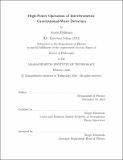High-power operation of interferometric gravitational-wave detectors
Author(s)
Buikema, Aaron.
Download1201526157-MIT.pdf (21.67Mb)
Other Contributors
Massachusetts Institute of Technology. Department of Physics.
Advisor
Nergis Mavalvala.
Terms of use
Metadata
Show full item recordAbstract
With the conclusion of the first two observing runs of the Advanced LIGO detectors, which saw the first direct detection of gravitational waves, we are firmly in the era of gravitational-wave astronomy. To reach the highest sensitivities, current interferometric gravitational-wave detectors are designed for hundreds of kilowatts of circulating optical power. At these high circulating powers, the sensitivity of the detectors to gravitational waves will be limited by the quantum properties of the light: shot noise at frequencies above ~ 100 Hz, and quantum radiation pressure noise at lower frequencies. To reach the high powers necessary for achieving the quantum noise limits imposed by the light, it is essential to solve the control problems and understand the additional noise introduced by high power operation. Additionally, development of high-power laser sources that reach the stringent noise and reliability requirements is crucial. This work comprises three experiments aimed at reaching the radiation-pressure-dominated regime of interferometric gravitational-wave detectors. The first part presents results from a high-power, meter-long Fabry-Prot Michelson interferometer to probe classical and quantum radiation pressure effects using a gram-scale mechanical oscillator. The second part is an exploration of the effects of electric fields and charging of test masses on the sensitivity of the LIGO detectors, which may limit the ability to observe radiation-pressure effects. Finally, we describe the development and characterization of a high-power, narrow-linewidth ytterbium-doped fiber amplifier for use in future gravitational-wave detectors.
Description
This electronic version was submitted by the student author. The certified thesis is available in the Institute Archives and Special Collections. Thesis: Ph. D., Massachusetts Institute of Technology, Department of Physics, February, 2020 Cataloged from PDF version of thesis. Includes bibliographical references (pages 157-172).
Date issued
2020Department
Massachusetts Institute of Technology. Department of PhysicsPublisher
Massachusetts Institute of Technology
Keywords
Physics.